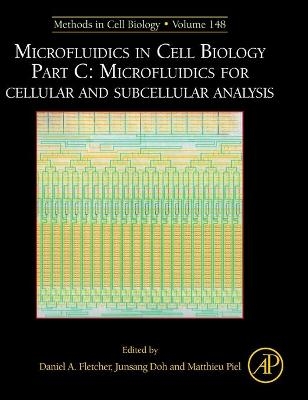
Microfluidics in Cell Biology Part C: Microfluidics for Cellular and Subcellular Analysis
Academic Press Inc (Verlag)
978-0-12-814284-4 (ISBN)
Matthieu Piel and his team develop microfabricated and microfluidic tools to quantitatively control the physical parameters of the cell’s environment and study how cells grow, divide and migrate. The team focused on how physical confinement, geometry and forces affect cell division and cell migration. The general aim of these studies is to draw a line between the physics of the active matter cells are made of and the behavior of cells in the complex environment of tissues, in the context of the immune response and tumor development. Dr. Fletcher and his team develops diagnostic technologies and studies mechanical regulation of membrane and cytoskeleton organization in the context of cell motility, signaling, and host-pathogen interactions. His lab specialize in development of optical microscopy, force microscopy, and microfluidic technologies to understand fundamental organizational principles through both in vitro reconstitution and live cell experiments. Recent work includes investigating the mechano-biochemistry of branched actin network assembly with force microscopy, studying membrane deformation by protein crowding and oligomerization with model membranes, and reconstituting spindle scaling in encapsulated cytoplasmic extracts. The long-term goal of his work is to understand and harness spatial organization for therapeutic applications in cancer and infectious diseases. Junsang Doh is an associate professor of Mechanical Engineering/Interdisciplinary Bioscience and Bioengineering (I-Bio) in POSTECH, South Korea. Prof. Doh’s group develops and utilizes engineering tools such as microfabrication/imaging/mechanics to study fundamental aspects of immune cell behaviors, including synapse-based cell-cell interactions and motility under complex microenvironments, in the context of cancer immunotherapy.
Section 1 Microfluidics for cell culture, cell manipulation and cell sorting1. Viable cell culture in PDMS-based microfluidic devicesMelikhan Tanyeri and Savas Tay2. High-throughput microfluidic single-cell trapping arrays for biomolecular and imaging analysisXuan Li and Abraham P. Lee3. Artificial niche microarrays for identifying extrinsic cell-fate determinantsSamy Gobaa, Raphael V. Gayet and Matthias P. Lutolf4. Reconstruction of directed neuronal networks in a microfluidic device with asymmetric microchannelsJosquin Courte, Renaud Renault, Audric Jan, Jean-Louis Viovy, Jean-Michel Peyrin and Catherine Villard5. Single-cell 3D electro-rotationLiang Huang, Peng Zhao, Fei Liang and Wenhui Wang
Section 2 Droplet-based microfluidics6. Direct quantification of EGFR variant allele frequency in cell-free DNA using a microfluidic-free digital droplet PCR assayBenjamin Demaree, Daniel Weisgerber, Ata Dolatmoradi, Makiko Hatori and Adam R. Abate7. Quantifying phenotypes in single cells using droplet microfluidicsFengjiao Lyu, Lucas R. Blauch and Sindy K.Y. Tang8. Modular microfluidics for double emulsion formationBryant Thompson, Nareh Movsesian, Christine Cheng, Prathamesh Karandikar, Malancha Gupta and Noah Malmstadt9. Universal anchored-droplet device for cellular bioassaysGabriel Amselem, Sébastien Sart and Charles N. Baroud
Section 3 Microfluidics for cellular analysis10. Cell biology at the interface of nanobiosensors and microfluidicsNikhil Bhalla, Hung-Ju Chiang and Amy Q. Shen11. BET-seq: Binding energy topographies revealed by microfluidics and high-throughput sequencingArjun K. Aditham, Tyler C. Shimko and Polly M. Fordyce
| Erscheinungsdatum | 06.12.2018 |
|---|---|
| Reihe/Serie | Methods in Cell Biology |
| Verlagsort | San Diego |
| Sprache | englisch |
| Maße | 191 x 235 mm |
| Gewicht | 680 g |
| Themenwelt | Naturwissenschaften ► Biologie ► Genetik / Molekularbiologie |
| Naturwissenschaften ► Biologie ► Zellbiologie | |
| ISBN-10 | 0-12-814284-7 / 0128142847 |
| ISBN-13 | 978-0-12-814284-4 / 9780128142844 |
| Zustand | Neuware |
| Haben Sie eine Frage zum Produkt? |
aus dem Bereich


